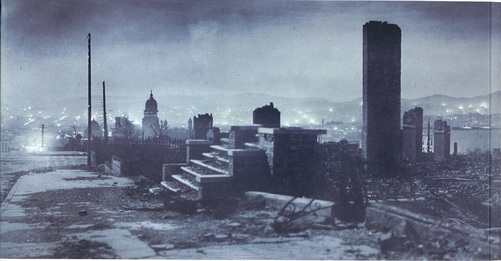American Art and Visual Culture: Destructive Creation (course offered from 2014-2015)
 Arnold Genthe, "Steps that Lead to Nowhere" (1906)
Arnold Genthe, "Steps that Lead to Nowhere" (1906)
DESTRUCTIVE CREATION: CHAOS, VIOLENCE AND CATASTROPHE IN AMERICAN ART (provisional outline)
taught by Dr. Hélène Valance
Historian Richard Slotkin demonstrated how violence has been a fundamental element in the construction of the American identity, paradoxically intertwining destruction with regeneration. The aim of this course will be to explore the contrary dynamics of creation and destruction and the various forms the relationship between art and violence can take. How do American artists conciliate destruction with their own processes of creation? Should one regard these reenactments of disaster as witnesses to anxieties, as ways to deflect violence, as sensationalist spectacles, or as mere sources of contemplation? From the days of the Frontier and the Civil war, to the traumas of the world wars and of the 9/11 attacks, this course will examine the interpretation of destruction in American visual arts and culture. It will address issues such as political violence, psychological instability, trauma, or ecological destruction, analyzing various visual forms of creation, from painting and sculpture to film and performance. We will consider the respective engagements of artists and viewers in artworks depicting or performing destruction, questioning the origins and effects of violence. Can one be said, for instance, to be the victim of an artwork’s violence? Conversely, what does the (self-)destruction of artworks tell us about their status and value, and about our relationship to art in general? Does the act of viewing an artwork constitute a creation or a destruction? The course will raise ethical issues about the aesthetics of violence, asking for instance how much of the formal freedom of abstraction originates in destruction; how much contemplation can counterbalance the destructive aspects of some artworks; or in what measure art can become a form of protest and disruption, anchoring artists and their works in their historical context rather than setting them apart from it and confining them to formal preoccupations.
taught by Dr. Hélène Valance
Historian Richard Slotkin demonstrated how violence has been a fundamental element in the construction of the American identity, paradoxically intertwining destruction with regeneration. The aim of this course will be to explore the contrary dynamics of creation and destruction and the various forms the relationship between art and violence can take. How do American artists conciliate destruction with their own processes of creation? Should one regard these reenactments of disaster as witnesses to anxieties, as ways to deflect violence, as sensationalist spectacles, or as mere sources of contemplation? From the days of the Frontier and the Civil war, to the traumas of the world wars and of the 9/11 attacks, this course will examine the interpretation of destruction in American visual arts and culture. It will address issues such as political violence, psychological instability, trauma, or ecological destruction, analyzing various visual forms of creation, from painting and sculpture to film and performance. We will consider the respective engagements of artists and viewers in artworks depicting or performing destruction, questioning the origins and effects of violence. Can one be said, for instance, to be the victim of an artwork’s violence? Conversely, what does the (self-)destruction of artworks tell us about their status and value, and about our relationship to art in general? Does the act of viewing an artwork constitute a creation or a destruction? The course will raise ethical issues about the aesthetics of violence, asking for instance how much of the formal freedom of abstraction originates in destruction; how much contemplation can counterbalance the destructive aspects of some artworks; or in what measure art can become a form of protest and disruption, anchoring artists and their works in their historical context rather than setting them apart from it and confining them to formal preoccupations.
